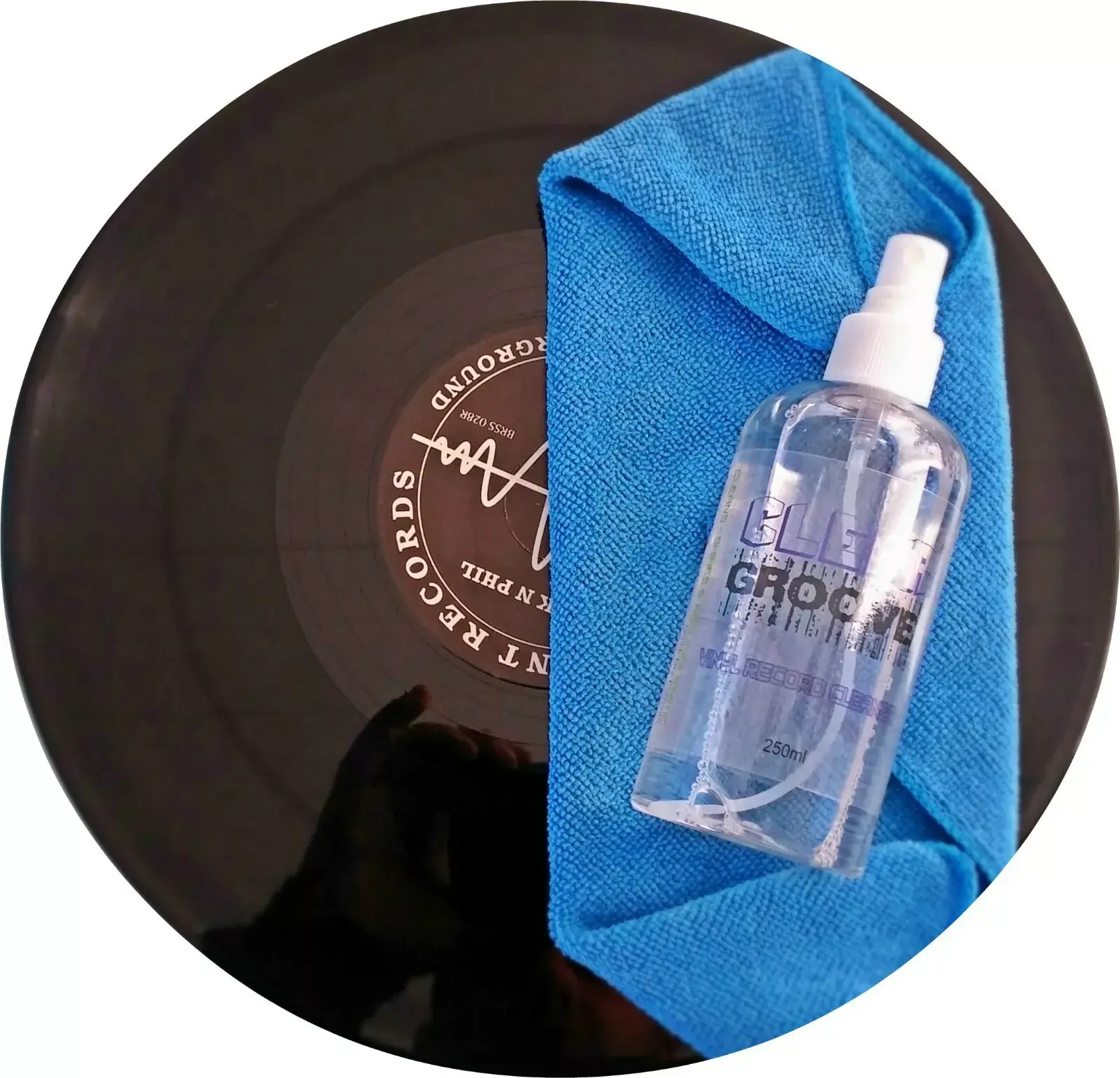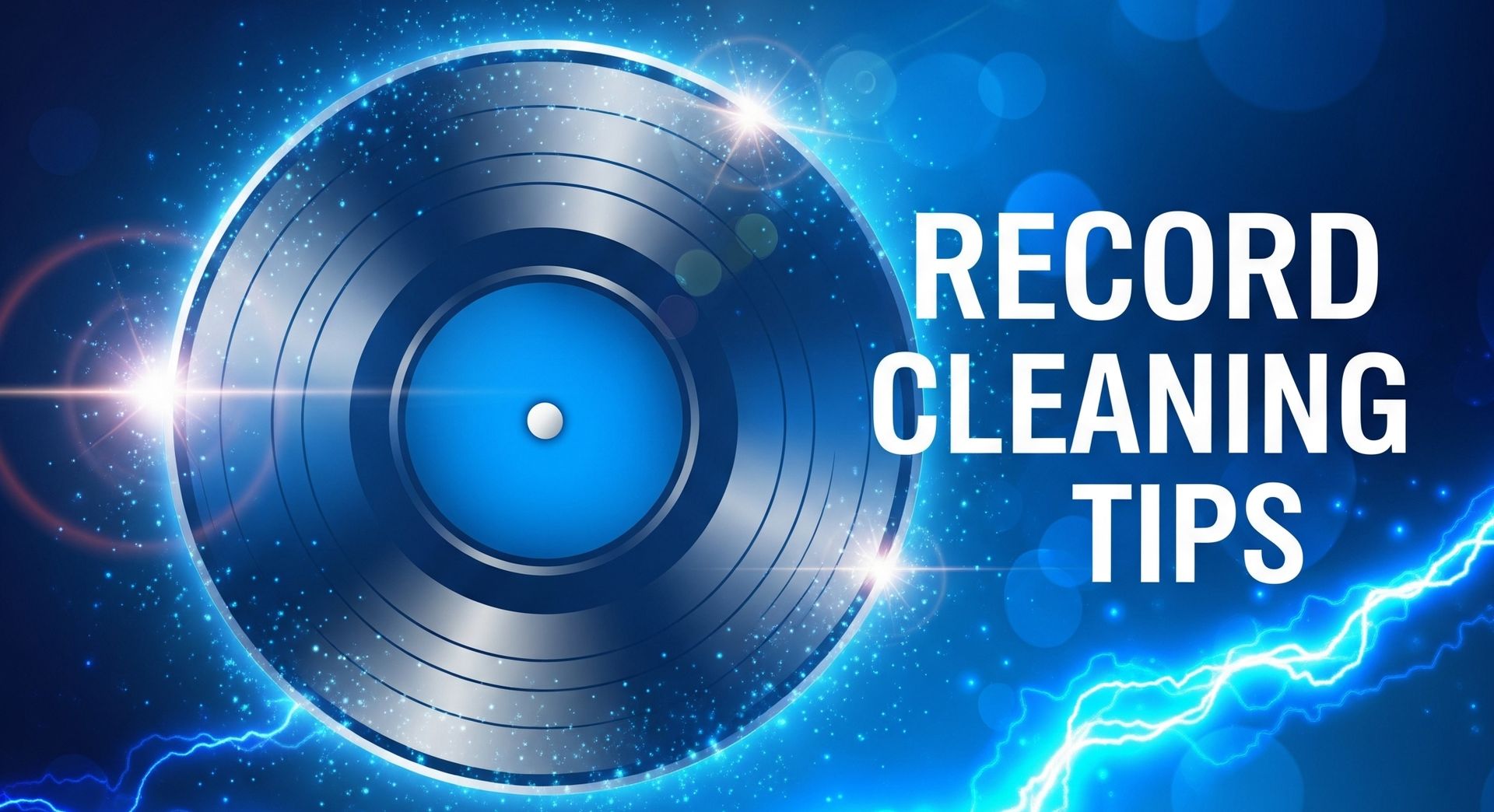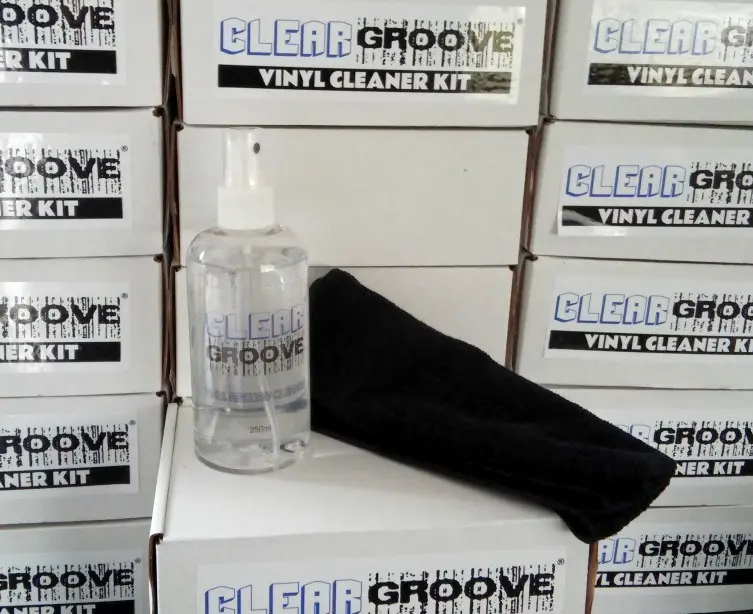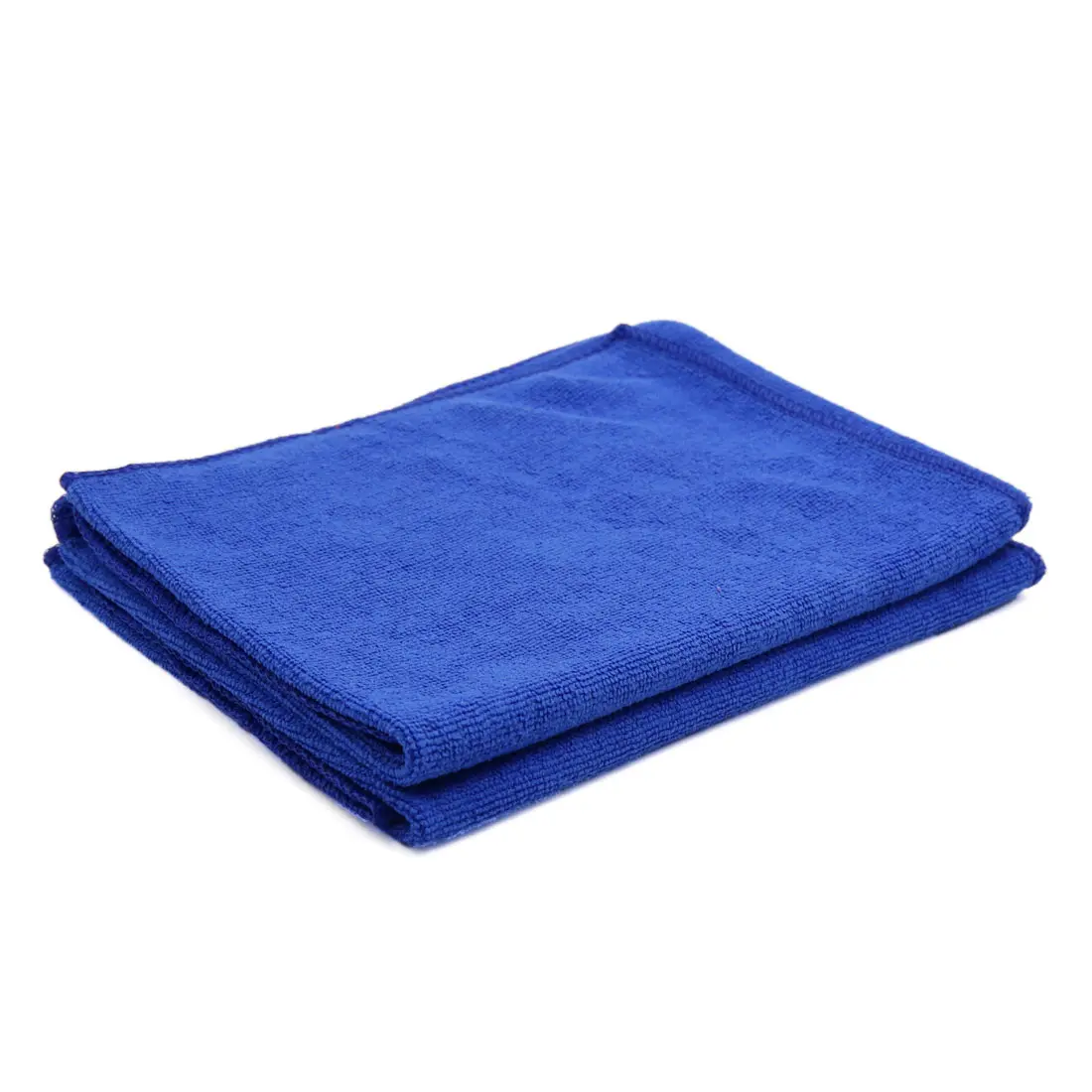Record Cleaning Tips:

Usage Guide for our Clear Groove Record Cleaning Kit:
1) Choose a flat, stable, clean surface on which to place the disc to be cleaned
2) Spray Fluid directly onto the surface of the record, avoiding the center label (1 to 3 sprays per side is usually ample for an average 12" cleaning)
3) Use the cloth to wipe around in a circular motion anti-clockwise, buffing several times
4) Wipe until completely dry, repeat above steps if necessary.
5) Flip over and repeat on the other side too - now you have a cleaner record its time to play it!
6) Give it a spin & turn up the volume! 🎶
Please make sure you follow the usage instructions on the bottle and use liberally on really soiled vinyl, ensuring you continue to wipe the fluid until completely dry (you don't want to leave any unwanted debris that have been loosened by the fluid left on the record) - repeating the cleaning process a couple of times will give great results.

Vinyl Cleaning
Even the most carefully looked after collection will gather microscopic dust over time and records that are played often easily become soiled with greasy fingerprint marks, dust and dirt that will massively affect sound quality!
Clear Groove is a fantastic cleaning spray for keeping your records as close to new as possible and will restore even the dirtiest of records.
After a clean your vinyl will also be free from static and shiny like new!
Top Record Cleaning Tips:
- Use fluid generously on really soiled records.
- Repeat the cleaning process several times if necessary to get all the dirt off.
- Clear Groove is very effective at loosening gunk, so make sure all this is transferred to the cloth and not left on the vinyl where it could cause distortion or collect on your needle.
- Keep buffing the record until the fluid has totally evaporated.
- Don't forget to keep your stylus and turntable platter clean
- Make Sure your stylus and other listening equipment are wired, weighted and set up correctly.
- Replace dusty old inner sleeves where appropriate
- Keep your records sealed in protective sleeves – these prevent dust, smoke, fumes & moisture in the atmosphere from coming in to contact with your records. They also keep fingerprint marks off your jackets & even provide some protection from being torn or creased!
- Never use household detergents on vinyl and even tap water, as its full of impurities.
- For delicate records like shellac & gramophone discs, use a dry method of cleaning or just pure distilled or reverse osmosis water, see our guide to disc types and cleaning methods
- Once your cloth has become soiled – buy a new one – washing it in the washing machine will leave soap residue that could cause streaking on your records – however, you could clean it in warm distilled water only.

Removing Static From Vinyl
Our Fluid effectively combats static but you can also use a special anti static gun or a brush kept next to your turntable for every day use.
Needle / Stylus Cleaning
With a little care you can keep your stylus clean and working at optimum performance.
It also goes without saying that cleaner records = cleaner stylus. If your disc surfaces are kept free of debris, then there will be nothing to collect on the needle!
Remember that this is the most delicate part of your equipment and always needs a careful approach to prevent damaging your needle.
Record Cleaning Machines (RCM)
For the real vinyl connoisseur an automatic record cleaning machine is the ultimate toy! Also available are the manual machines that you wind up.
Our fluid is suitable for all types of RCM as a replacement for the fluid supplied and will produce fantastic results.
It can be used straight out of the bottle or further diluted to go further – please see our large volume refills. All our fluids are suitable for both manual and electronic record cleaning machines but check manufactures instructions.
Ultrasonic Record Cleaning Machines: An ultrasonic record cleaner is a sophisticated device that uses high-frequency sound waves to thoroughly and gently clean vinyl records. It's often considered the most effective way to remove microscopic dirt, dust, oils, and other contaminants from the delicate grooves of a record, leading to significantly improved sound quality and extended record/stylus life. Crucially, this cleaning process happens at a microscopic level without any direct physical contact from brushes or cloths on the record's delicate grooves. This eliminates the risk of scratching or embedding particles deeper into the vinyl. You still need to use a liquid with an ultrasonic cleaner and combined with our Clear Groove Fluid you will have the ultimate combination and be on the Path to Perfect Playback!
Cleaning Non Vinyl Records / old 78's / Acetates / Shellac:
Whilst most modern discs are vinyl (PVC) - some older era gramophone records & special discs are not made from vinyl and can be more delicate. Some also have special coatings which can be removed by standard cleaning fluids. As such these should be cleaned with great care - we recommend pure water only. More about other disc types below.
FAQS:
How to clean records and get the best sound from your vinyl.
Restoring vinyl records does not have to be difficult, costly or time consuming. Our cleaning fluid and cloth kits are the easiest effective method to quickly clean your 12" LPs and 7"s
Will it improve sound quality of the record and reduce background noise / distortion?
In most cases Yes of course, a good clean will free any microscopic debris which adversely affects sound quality. It's important to remember to use the fluid liberally and continue to wipe until completely dry. Our fluid is designed to remove even the most stubborn dirt from records.
Can you repair a scratched record & how about preventing records From skipping / Jumping?
No you cant repair physical damage, but its often the case that pops and crackles are caused by dirt & dust particles, which can be completely removed with the use of our advanced cleaning liquid. The fluid can dissolve even the most stubborn dried on muck.

What Ingredients does Clear Groove fluid contain?
Our exact recipe is a closely gaurded secret - Its a unique advanced formula containing alcohol and special agents. A tried and tested solution.
Does Alcohol damage vinyl?
It's a common question among vinyl enthusiasts, and the answer is nuanced: alcohol can be used to clean vinyl records, but it requires caution regarding the type, concentration, and frequency of use. When formulated correctly, it is both safe and effective. While claims of alcohol damaging vinyl records are often voiced, these assertions are largely anecdotal and tend to overlook the complex interplay of various factors.
The record itself: Its age, the specific PVC formulation, and its current condition.
The solvent: The type of alcohol. its concentration, and its purity.
The cleaning method: and the materials used (e.g., brush type, cloth quality).
Environmental Conditions: The temperature and humidity during cleaning and drying can significantly affect how fast a solvent evaporates and whether it leaves residue.
Post-Cleaning Handling & Storage: How the record is dried (e.g., air-dried vs. vacuum-dried, vertical vs. horizontal), and how it's subsequently stored (e.g., in poly-lined vs. paper sleeves) can influence residue accumulation or physical stress over time.
Frequency and Duration of Exposure: A single, brief cleaning session is very different from repeated, long-duration exposures, which could potentially have cumulative effects the vinyl surface.
Type and Age of Contaminants: The specific nature of the dirt (e.g., dust, mold, cigarette smoke residue, fingerprints, or original pressing plant lubricants) will react differently to various solvents, influencing cleaning effectiveness and potential interactions with the vinyl.
Any form of physical cleaning introduces some minute level of wear over time. (As does playing it on your turntable!) The key, then, is a balance: it's a trade-off between the inevitable, albeit minimal, wear from cleaning and the significant sonic and longevity benefits of a clean, playable record. Ultimately, a carefully cleaned record will almost always sound better and last longer than a dirty one.
While our formula is fine for cleaning modern vinyl (PVC) records, it should never be used on gramophone shellac 78 RPM records

DISC TYPES & HISTORY OF THE FORMAT :
You most likely own vinyl records but if you collect, have one or two non vinyl discs in your collection or ever encounter strange discs then here's a guide to looking after them!gramophone discs cleaning
Its true that playing any type of record causes a gradual degradation of the recording, They need to be stored on edge and not exposed to extreme temperatures or humidity. The medium needs to be kept clean.
DISC TYPE: STANDARD VINYL RECORDS (1930-NOW)
Including 12" / 7" / 10" / LP's / Jukebox Discs / Picture and Transparent discs.
NOTES: Most non-vintage records are made from vinyl (Poly vinyl Chloride). They are referred to as micro-groove records, and play at 45 or 33 rpm. Formats include 7" 45 rpm discs with oversized spindle holes, 10" and 12" long plays (LPs), extended plays (EPs) and others.
#RCA produced some vinyl discs in the early 1930's but they didn't fully take off until after the second world war in 1949.
Vinyl is much lighter and more flexible than the old shellac discs, pretty much all modern records are made from vinyl.
The 'Orange Peel' Effect: You may sometimes notice a feint texture to a record that's looks a bit like orange peel. This is actually worn mould and does cause noise on the record especially in low frequency. Sometimes however the master disc used to cut the record had the orange peel effect and in this instance there is no ill effect as there is no distortion to the grooves.
CLEANING METHODS: Grease, Grime, Dirt, Tea, Coffee, Beer, Ash - Yes you vinyl can quickly become covered in all sorts of stuff - Our record cleaning solutions can be used on all types of vinyl to quickly and easily restore them to former glory!
Ensuring we use only the purest, highest grade ingredients and in the correct concentration decreases the risk of any potential negative reaction, leaching or residue left behind.
Any cleaning substance or method may cause wear over time - Of course even playing a record does! Generally speaking if done correctly cleaning your discs will only enhance your listening experience : )
DISC TYPE: VERY EARLY RECORDINGS (1880's - 1895)
NOTES: The earliest reordered discs were made from various materials including rubber until shellac became the standard in around 1895.
CLEANING METHODS: Its very unlikely to come across discs from this era but obviously cleaning them should be done with extreme care if at all, certainly don't use any type of solvent. Pure water only.
DISC TYPE: VINTAGE 78's SHELLAC (1895-1950)
NOTES: During the 78rpm era records were made from shellac which is actually a natural secretion from a type of beetle! - in the early days speeds actually ranged from 60rpm to 130 rpm but were standardised by around 1925. Most countries ceased production of shellac in favour of vinyl by around 1950. They are also referred to as coarse-groove or short play (SP) records. Most commonly, vintage disc records are referred to as ‘78s’, referring to a speed of 78 revolutions per minute (rpm).
Shellac 78's can be identified by the inflexible, heavy, brittle like feel and of course date, if its pre 1940's then its most likely a shellac disc. Generally, 78s were 10-inch, but 12-inch and 7-inch and even smaller were made.
The formula for these discs varied by manufacturer but was usually a third shellac with 2 parts mineral & filler (such as limestone and cotton) they also added carbon for the black colour and a small amount of lubricant.
Generally speaking all 78's are some sort of shellac and the material ceased being used when the 78rpm disc ceased production in 1950's.
For nostalgic purposes some companies did produce a very small number of 78'rpm discs after the 1950's but these were normally microgroove (normal vinyl - not shellac) despite being the 78rpm speed.
SHELLAC CLEANING METHODS: Cleaning non vinyl should always be done with great care if at all. Since shellac can dissolve in ethanol and most other solvents, dry brushing or pure water is advised for cleaning only. Gently rubbing with a damp cloth in the direction of the grooves will remove most of the dirt. This should be done on a soft flat surface to prevent cracking the disc, and let the record air-dry before placing it back in the sleeve. Our Pure water base product Rinse Out is available In the shop
LAQUERED DISCS / OTHER COATINGS:
Although this is something you are rarely likely to encounter with vinyl there were some early records that had a lacquer coating. These should be treated the same as standard shellac and solvents should not be used. Read on for more disc types including acetates and flexi discs.....
DISC TYPE: PICTURE DISCS / SHAPED VINYL
These are vinyl records and can be cleaned in the same way as standard black vinyl.
DISC TYPE: FLEXI DISCS
Flexi discs are very thin normally transparent records that were usually given away free with magazines during the 70's and 80's although some have also appeared recently as novelty releases. They can be safely cleaned with standard record cleaner.
DISC TYPE: ACETATES / DUBPLATES
Acetate records (normally 12" or 10") are generally demo / promo / studio or homemade releases. Whilst they look much like vinyl they have a much softer texture, are heavier and brittle. They will often come in the mastering companies generic sleeve and have track information stamped or hand written on. Repeated playing decreases the sound quality as they are not intended for repeated listening. Most of the acetates you will find have been used, there will usually be a bit of a hiss / background noise to them. They are usually produced as test discs and you may sometimes find rare and unreleased material on them.
Cleaning them is not recommended as this will generally just cause more distortion however for a really dirty disc just pure water can be used.
DISC TYPE: WHITE LABEL / PROMOS
Do not confuse acetates with standard vinyl 'white labels' or promos which are usually just vinyl records with a plain label, you can tell an acetate disc by the way it feels (heavy / brittle / soft and waxy) white labels can be cleaned in same way as other vinyl records.
DISC TYPE: Compact Discs (CD / DVD / Laserdiscs)
CDs can be cleaned safely and effectively with most fluids intended for record cleaning, we also supply a dedicated CD cleaning kit.
For best results allow to air dry naturally and use gloves or hold CD around the edge to prevent greasy finger marks.

